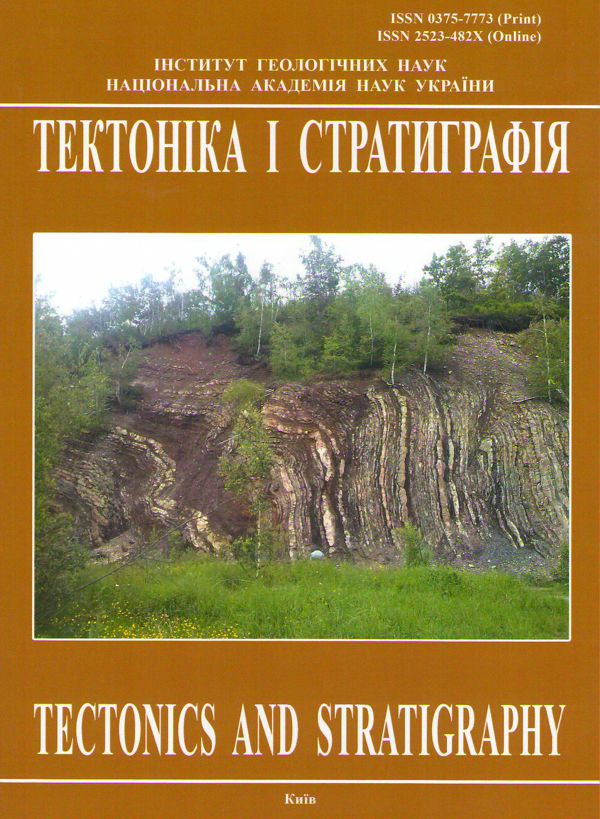ГЕОЛОГО-ГЕОХІМІЧНІ ЧИННИКИ ПАРАГЕНЕЗУ ВУГЛЕВОДНЕВОВМІЩУВАЛЬНИХ І ВУГЛЕНОСНИХ ФОРМАЦІЙ
DOI:
https://doi.org/10.30836/igs.0375-7773.2017.147553Ключові слова:
парагенез, нафта, газ, вугілля, горючі сланці, осадові басейниАнотація
Розглянуто проблему парагенезису вугільних і вуглегазових формацій, ґрунтуючись на уявленнях про широкомасштабний вплив на осадові товщі енергетично насичених надглибинних флюїдів. Парагенезис передбачає закономірне спільне розміщення генетично пов’язаних між собою мінералів. Здебільшого нафту й вугілля на спільних площах не розробляють. Водночас це свідчить про те, що глибинні вуглеводні, виливаючись на денну поверхню, блокують процеси окиснювання в болотах і озерах. Під час міграції в осадовій товщі вони безпосередньо входять до складу торфу, вугілля, сапропелю, горючих сланців тощо.
Найсуттєвішим чинником впливу в генезисі родовищ вуглецевовмісних корисних копалин (нафти, газу, вугілля, горючих сланців тощо), які мають спільне джерело для формування кінцевого продукту, є геолого-геохімічний, що однозначно вказує на генетичний зв’язок кінцевого продукту з геодинамічними особливостями розвитку осадових басейнів і окремих товщ у його межах унаслідок дії теплової енергії, термобаричних, флюїдодинамічних глибинних коромантійних високоенергетичних флюїдних потоків і механізмів їхньої взаємодії з літосферними субстратами як відображення процесу розвантаження в земній корі мантійних вуглеводневих систем.
Посилання
Kusov B.R. 2010. Coal formation. The new insights at the known facts. Domestic geology, no. 3, p. 76-80. – in Russian
Botneva T.A., Eremenko N.A., Nechaeva O.L. 1999. On the oil deposit formation due to the receipt of hydrocarbon fluids supply from various sources. Geology of oil and gas. no. 1-2, p. 39-43. – in Russian
Yakubiants T.A. 1988. Morphostructural analysis of coal deposits – Moscow: Nedra, 126 p. – in Russian
Khasanov R.R., Kizilstein L.Ya., Gafurov Sh.Z. 2001. Petrographic types of Visean coals in the Kamsky basin. Atlas – Kazan: Kazan University, 176 p. – in Russian
Gradzinsky R. 1980. Sedimentology. Moskva: Nedra, 640 p. – in Russian
Coal base of Russia. 2004. The main regularities of coal formation and coal deposition on the territory of Russia. Moskva: Geoinformmark, Volume VI, 779 p. – in Russian
Gavrilov V.P. 2008. Possible mechanisms of natural reserves replenishment at oil and gas fields. Geology of oil and gas. no. 1, p. 56-64. – in Russian
Rosly I.S. 2003. Geodynamic, structural-tectonic and lithologic-stratigraphic control of oil and gas deposits formation and location in the Dnieper-Donets basin. Genesis of oil and gas. p. 275-277. – in Russian
Larin V.N. 1980. Hypothesis of the initially hydride Earth. – Moskva: Nedra, 216 p. – in Russian
Bardin O.O., Bardina O.O. 2003. The scientific work "Estimation of juvenile hydrogen reserves in the core of the earth, grounding the mechanism of its accumulation at the stage of accretion, the mechanism of migration at the stage of oil and gas formation and extraction technology". Certificate of the State Department of Intellectual Property on the registration of copyright. no. 7729, 18 p. – in Ukrainian
Chebanenko I.I., Evdoshchuk N.I., Klochko V.P., Tokovenko V.S. 2008. Sedimentary-inorganic theory of oil and gas fields formation. Geology of oil and gas. no. 5, p. 50-52. – in Russian
Shnyukov E.F., Gozhyk P.F., Krajushkin V.A., Klochko V.P. 2007. Three steps from the submarine gas hydrate production. Geology and minerals of the World Ocean. no. 1, p. 32-51. – in Russian
Kusov B.R. 2010. Genesis of certain carbon minerals (from methane to diamond) – Vladikavkaz: IPO SOIGSI, 164 p. – in Russian

